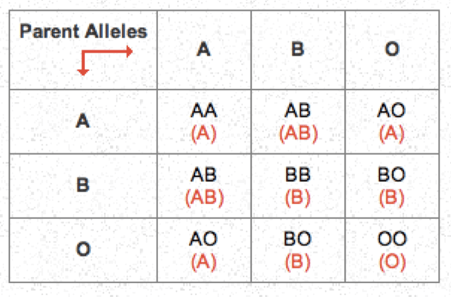What determines blood type?
Contained within their cell membranes, some red blood cells have special glycolipids called A and B glycolipids. People with blood type A have the A glycolipid in their cell membranes, people with blood type B have the B glycolipid in their cell membranes, and people with blood type AB, have both glycolipids in their cell membranes. People with blood type O, however, have neither glycolipid in their cell membranes (think of the smooth surface of the letter O and picture a cell membrane with a smooth surface without A or B glycolipids).
Why do healthcare providers care about matching blood types during blood transfusions?
When a person receives a blood transfusion, it is very important that they receive the correct blood type. If a person receives the incorrect blood type, it can lead to a very dangerous immune response. Here is why that happens:
As you may already know, antibodies are part of your body’s defense system and they are used to help attack anything foreign found in the body. Antibodies function by destroying foreign bodies or marking them for destruction by some other component of the immune system. A healthy person would not make antibodies against anything that is normally found in their body. For example, if you have AB blood, your body would not make antibodies against A or B glycolipids. If you have O blood, however, your blood does not contain A or B glycolipids. As a result, your body would recognize the A and B glycolipids in A, B, and AB type blood as foreign and produce antibodies against them. More generally, a person will produce antibodies against any blood glycolipid that doesn’t already exist in their blood type.
This can create a problem during blood transfusions; if you give someone blood that they have antibodies against, their immune system will work to destroy the donated blood and the process will lead to dangerous inflammation. As a result, people can only receive blood donations from blood types that they do not have antibodies against. This is why O is called the universal donor (O contains neither A nor B glycolipids so it does not induce an antibody response in anyone) and AB is called the universal recipient (AB blood contains both A and B glycolipids so a person with this blood type will not make antibodies against any other blood type).
How is blood type inherited?
For the most part, blood type is inherited similarly to many traits that you have likely already covered in your biology course. In fact you can use punnett squares to determine the genotype and phenotype of offspring. One interesting difference between blood type and some other traits, however, is that there is not a single inheritance pattern that governs all of the blood types. Blood type O is always recessive, so it requires two copies of the O allele for an offspring to demonstrate the O phenotype. Blood types A and B are codominant to each other, meaning that if a person inherits the A allele from one parent and the B allele from the other parent, both traits will be expressed and the offspring will have AB blood type. While blood types A and B are codominant to each other, they are both dominant to the O allele. As a result, you can have blood type A or B either by inheriting two copies of the A or B allele or by inheriting one copy of the A or B allele and one copy of the O allele. See the chart below for offspring genotype and phenotype for all of the potential parental alleles.

Note: the writing in red indicates offspring phenotype
http://sites.saschina.org/audreypx2016/2015/01/28/the-inheritance-pattern-of-many-traits-cannot-be-explained-by-simple-mendelian-genetics/
A quick summary of the genotypes, phenotypes, and antibodies for all four blood types:

Note: The alleles for A and B are indicated with a capital I and an A or B superscript. The allele for O is indicated with a lowercase i.
Comments